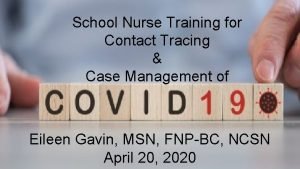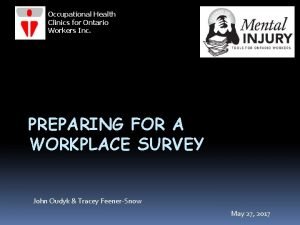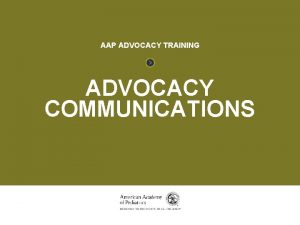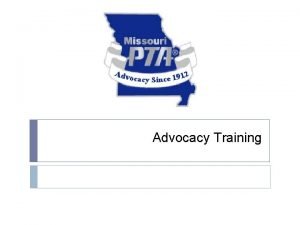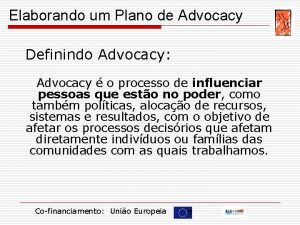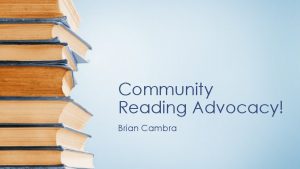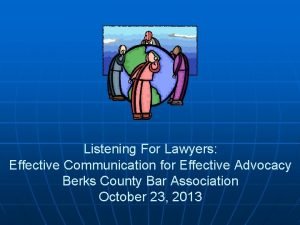EFFECTIVE ADVOCACY FOR COMMUNITY HEALTH WORKERS Community Health

















- Slides: 17

EFFECTIVE ADVOCACY FOR COMMUNITY HEALTH WORKERS Community Health Worker Course Rogue Community College

WHAT WE WILL COVER Types of advocacy Advocacy toolbox How to advocate effectively Resources

WHAT DO WE MEAN WHEN WE SAY “ADVOCACY? ”

WHAT IS ADVOCACY? Advocacy – noun The act or process of supporting a cause or proposal: the act or process of advocating for something. Source: www. merrimanwebster. com/dictionary/advocacy

TYPES OF ADVOCACY 1. Self-Advocacy: Where one represents themselves by speaking about their own rights and interests. Seeking a solution on your own. 3. Systems or Group Advocacy: To influence systems (either social or political) for changes involving groups of people. 2. Individual Advocacy: Speaking for or acting on the behalf of another person to achieve change, protect rights, or achieve justice for someone. 4. Legal or Representative Advocacy: This involves both litigation and legislation for groups or classes of people.

SETTINGS FOR CHW ADVOCACY Within the Treatment Team With various agencies/organizations involved in the client’s life (Child Welfare, CCOs, Legal, Social Services, Education, etc. ) With governmental bodies (City Council, County Government, the State of Oregon) For individuals or groups of people served. For Community Health Work in general.

NOW WHAT?

9 QUESTIONS THAT WILL AIDE YOU IN ADVOCACY What are you asking for? Who can help you achieve this? What do they need you to tell them? Who is the right person to tell them? What is the best way to get them to hear you? What do you already have in place? What are the specific needs? What is the first step? How will you know if change has occurred?

STRATEGIES FOR EFFECTIVE ADVOCACY 1. Make sure your client is on the same page: � Communicate about what you are advocating for. � Make sure they are onboard with what you are doing. � Help them to advocate for themselves whenever possible. 2. Know your audience. � Be prepared with the right kind of information � Be prepared to answer questions � Be prepared with hard data as well as real stories.

MORE STRATEGIES 3. Know your setting. � How much time do you have? � Where are you? � Ensure confidentiality at all times. 4. Be prepared to answer the following questions: � What is the issue? � Is there a solution? � Who is involved? � What contributes to the problem? � What contributes to the solution?

MORE STRATEGIES 5. Make sure you are advocating to the correct person/decision making body. 6. Make sure you know the individual’s rights. � Research laws and regulations whenever possible. � Identify policies and procedures. 7. Find and engage with allies. 8. Identify potential opposition and prepare to counteract it.

EVEN MORE STRATEGIES 9. Identify existing resources that already exist that either need to be enacted, improved upon, or supported. 10. Remember the 3 Ps of Advocacy � Politeness � Patience � Persistence

WHAT NOT TO DO WHEN ADVOCATING Lie Complain Speak just to be heard Send the wrong messenger

HOW CAN WE HELP OUR CLIENTS FEEL EMPOWERED TO ADVOCATE FOR THEMSELVES? Use person first language. Remember “Nothing about us without us!” Support them to participate in advocacy whenever you can. Help clients learn advocacy skills.

ADVOCACY RESOURCES

CHW Advocacy Toolkit: http: //peersforprogress. org/wpcontent/uploads/2013/12/20131206_wg 6_chw_adv ocacy_toolkit. pdf Governor’s Advocacy Office: http: //www. oregon. gov/DHS/aboutdhs/pages/gao. a spx Disability Rights Oregon: http: //www. disabilityrightsoregon. org/ Oregon Health Plan Client Information: http: //www. oregon. gov/oha/healthplan/pages/clients /main. aspx

 Natalia agapitova
Natalia agapitova Importance of advocacy in community
Importance of advocacy in community Health advocacy essay
Health advocacy essay Basic training for barangay health workers
Basic training for barangay health workers Basic training for barangay health workers
Basic training for barangay health workers Barangay health workers duties and responsibilities
Barangay health workers duties and responsibilities Basic training for barangay health workers
Basic training for barangay health workers C.d.c. covid isolation health workers
C.d.c. covid isolation health workers Covid isolation health workers
Covid isolation health workers C.d.c. covid isolation health workers
C.d.c. covid isolation health workers Covid isolation health workers
Covid isolation health workers Chapter 2 career skills in health informatics
Chapter 2 career skills in health informatics Occupational health clinic for ontario workers
Occupational health clinic for ontario workers Fspos vägledning för kontinuitetshantering
Fspos vägledning för kontinuitetshantering Typiska novell drag
Typiska novell drag Nationell inriktning för artificiell intelligens
Nationell inriktning för artificiell intelligens Ekologiskt fotavtryck
Ekologiskt fotavtryck Varför kallas perioden 1918-1939 för mellankrigstiden
Varför kallas perioden 1918-1939 för mellankrigstiden







